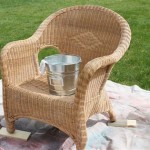How to Remove Rust from Outdoor Furniture
Outdoor furniture, exposed to the elements, is susceptible to rust formation. Rust not only detracts from the aesthetic appeal of your patio or garden set but can also compromise the structural integrity of the furniture over time. Identifying and addressing rust promptly is essential for maintaining the longevity and beauty of your outdoor pieces. This article outlines effective methods for removing rust from various types of outdoor furniture, ensuring their continued use and enjoyment.
Rust, scientifically known as iron oxide, is a product of oxidation. This process occurs when iron or iron alloys, like steel, are exposed to oxygen and moisture. The presence of electrolytes, such as salt, accelerates the process. Outdoor furniture is particularly vulnerable due to its constant exposure to rain, humidity, and fluctuations in temperature. Early detection and treatment are critical to prevent the rust from spreading and causing irreparable damage.
Understanding Rust Removal Principles
The success of rust removal hinges on disrupting the chemical bond between the iron oxide and the base metal. Various methods achieve this through mechanical abrasion, chemical reactions, or a combination of both. The choice of method depends on the severity of the rust, the type of metal the furniture is made of, and the availability of tools and cleaning agents. It is important to test any cleaning solution on an inconspicuous area of the furniture before applying it to the entire surface to ensure it does not cause discoloration or damage. Always wear appropriate safety gear, including gloves and eye protection, when working with chemicals or abrasive tools.
For light surface rust, gentler methods are usually sufficient. Heavy rust, however, requires more aggressive techniques. Regardless of the method employed, thorough cleaning and drying are essential to prevent the rust from recurring. Applying a protective coating, such as paint or a rust inhibitor, will further safeguard the furniture against future corrosion.
Methods for Removing Rust
Several methods can be used to remove rust from outdoor furniture, ranging from household solutions to specialized products. Each method has its own advantages and disadvantages, and the most suitable approach will depend on the specific circumstances.
1. Vinegar: White vinegar is a readily available and relatively mild acidic solution that can effectively dissolve rust. To use vinegar, soak the rusted area in vinegar for several hours or overnight. For larger items, you can soak a cloth in vinegar and apply it to the rusted surface. After soaking, scrub the area with a stiff brush or abrasive pad to remove the loosened rust. Rinse thoroughly with water and dry completely. Vinegar is particularly effective for removing light to moderate rust, and it is a less harsh alternative to stronger chemical solutions.
2. Baking Soda: Baking soda, also known as sodium bicarbonate, is a mild abrasive and alkali that can help to neutralize rust and loosen its grip on the metal surface. Mix baking soda with water to form a thick paste. Apply the paste to the rusted area and let it sit for several minutes. Then, scrub the area with a brush or abrasive pad. Rinse well with water and dry thoroughly. Baking soda is generally safe for use on most metal surfaces and is a good option for more delicate pieces.
3. Lemon Juice and Salt: The combination of lemon juice and salt creates a natural rust remover. The citric acid in lemon juice helps to dissolve the rust, while the salt acts as a mild abrasive. Sprinkle salt liberally on the rusted area, then squeeze lemon juice over the salt. Allow the mixture to sit for a few hours, then scrub with a brush or abrasive pad. Rinse thoroughly with water and dry completely. This method is particularly effective for smaller rust spots.
4. Commercial Rust Removers: Numerous commercial rust removers are available in liquid, gel, or spray form. These products typically contain stronger acids or chemicals designed to dissolve rust quickly and effectively. When using commercial rust removers, it is crucial to follow the manufacturer's instructions carefully. Always wear gloves and eye protection, and work in a well-ventilated area. Apply the rust remover to the affected area, allow it to sit for the recommended time, and then scrub with a brush or abrasive pad. Rinse thoroughly with water and dry completely. Commercial rust removers are highly effective for removing heavy rust but should be used with caution to avoid damaging the underlying metal or surrounding surfaces.
5. Mechanical Abrasion: For stubborn rust, mechanical abrasion may be necessary. This involves using tools such as wire brushes, sandpaper, or power tools like grinders or sanders to physically remove the rust. When using mechanical abrasion, it is important to start with a coarse grit and gradually move to finer grits to avoid scratching the metal surface. Apply consistent pressure and work in a methodical manner to ensure even removal of the rust. Wear safety glasses and a dust mask to protect yourself from debris. After removing the rust, clean the area thoroughly and apply a protective coating to prevent future corrosion. Mechanical abrasion is effective for removing heavy rust but requires more effort and skill.
6. Oxalic Acid: Oxalic acid is a stronger chemical compound used for rust removal. It is available in powder form and needs to be mixed with water according to the manufacturer’s directions. Wear gloves and eye protection when handling oxalic acid. Apply the solution to the rusted areas, allowing it to react for a specified time. Scrub the surface afterward and rinse thoroughly with water. Use with caution, especially on painted or coated furniture, as it may affect the finish.
Specific Considerations for Different Furniture Materials
The material of your outdoor furniture will significantly influence the rust removal method you choose. Different metals react differently to various cleaning agents and abrasive tools. Therefore, understanding the composition of your furniture is paramount.
1. Wrought Iron: Wrought iron, a common material for outdoor furniture, is particularly susceptible to rust. For wrought iron furniture, mechanical abrasion with a wire brush or sandpaper is often the most effective method. After removing the rust, apply a rust-inhibiting primer and a coat of exterior paint designed for metal. Regular cleaning and maintenance are crucial to prevent rust from recurring on wrought iron furniture.
2. Aluminum: While aluminum itself does not rust, it can corrode and develop a white, powdery residue. To remove this residue, use a mild detergent and water, scrubbing with a soft brush or cloth. Avoid using harsh chemicals or abrasive cleaners, as they can damage the aluminum surface. For more stubborn corrosion, a specialized aluminum cleaner may be necessary. After cleaning, apply a protective wax or sealant to help prevent future corrosion.
3. Steel: Steel furniture is prone to rusting, especially if the protective coating is damaged. Follow similar procedures for wrought iron: remove rust by mechanical abrasion or chemical treatment. After removal, apply a rust-inhibiting primer and exterior paint. Pay special attention to joints and crevices where rust is likely to form. Regular inspection and touch-up painting can help prolong the life of steel furniture.
4. Stainless Steel: Despite its name, stainless steel can still develop rust, especially in marine environments. Use a stainless steel cleaner and a soft cloth to remove surface rust. Avoid using abrasive cleaners or steel wool, as they can scratch the surface. For more stubborn rust, a specialized stainless steel rust remover may be necessary. After cleaning, apply a stainless steel polish to help protect the surface.
Preventing Future Rust Formation
Prevention is always better than cure when it comes to rust. Taking proactive steps to protect your outdoor furniture from moisture and corrosion can significantly extend its lifespan and maintain its aesthetic appeal.
1. Regular Cleaning: Regular cleaning is essential for preventing rust. Wash your outdoor furniture with soap and water every few weeks to remove dirt, grime, and salt buildup. This will help to prevent corrosion from starting in the first place.
2. Protective Coatings: Applying a protective coating, such as paint, varnish, or a rust inhibitor, can create a barrier between the metal and the environment. This will help to prevent moisture from reaching the metal surface and causing rust. Inspect the coating regularly and touch up any damaged areas promptly.
3. Proper Storage: During the off-season, store your outdoor furniture in a dry, covered area, such as a garage, shed, or basement. This will protect it from the elements and prevent rust from forming. If you must store the furniture outdoors, cover it with a waterproof tarp or furniture covers. Ensure the covers are breathable to prevent moisture from trapping underneath.
4. Rust Inhibitors: Apply rust inhibitors to metal surfaces, especially in areas prone to rust formation, such as joints and crevices. These products create a protective layer that prevents moisture and oxygen from reaching the metal.
5. Drainage: Ensure that rainwater can drain properly from your outdoor furniture. If water pools on the surface, it will eventually lead to rust. Drill drainage holes in areas where water tends to accumulate.
6. Powder Coating: Consider powder coating metal furniture. This provides a durable, uniform finish that is resistant to scratches, corrosion, and UV damage. Powder coating is a more involved process but offers superior protection compared to traditional painting.

How To Remove Rust From Metal Patio Furniture

7 Ways To Remove Rust From Metal Furniture

7 Ways To Remove Rust From Metal Furniture

7 Ways To Remove Rust From Metal Furniture

How To Paint An Outdoor Metal Chair Hgtv

How To Fix Old Rusty Metal Furniture Make It Stunning

10 Best Ways To Remove Rust From Metal Furniture With Easy Steps Abbotts At Home

A Fix For Rusted Outdoor Furniture Green With Decor

10 Most Efficient Ways To Remove Rust From Metal Furniture Az

Remove Stubborn Rust From Your Outdoor Furniture With This Kitchen Staple




